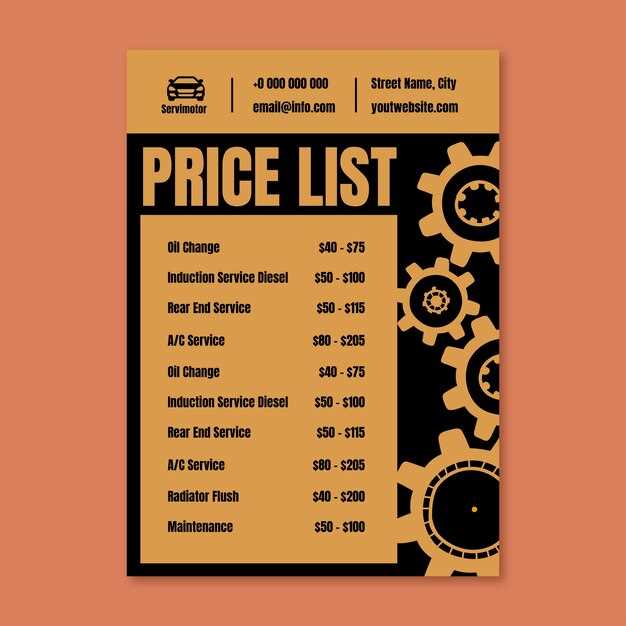
Proper car maintenance is essential for ensuring the longevity and performance of your vehicle. A well-structured maintenance schedule not only enhances the efficiency of the car but also ensures the safety of the driver and passengers. Regular care and attention can help detect potential issues before they escalate, saving both time and money in the long run.
Establishing an effective car maintenance schedule involves understanding the specific needs of your vehicle based on its make, model, and age. Regular tasks include oil changes, tire rotations, brake checks, and fluid level inspections. By adhering to a consistent timetable, you can ensure that your car remains in optimal condition and can perform reliably under varying driving conditions.
Moreover, integrating seasonal checks into your maintenance routine can prepare your car for challenging weather conditions, whether it be icy winter roads or the heat of summer. In this article, we will guide you through the essential components of creating a personalized car care plan that suits your lifestyle and driving habits, highlighting the critical aspects that contribute to a smoother driving experience.
Determining Key Maintenance Intervals for Your Vehicle

Establishing a consistent car maintenance schedule is vital for the long-term health of your vehicle. Key maintenance intervals should be determined based on the manufacturer’s recommendations, which can usually be found in the owner’s manual. These guidelines offer insights into when specific services, such as oil changes, tire rotations, and brake checks, should be performed.
Regular oil changes are often advised every 5,000 to 7,500 miles, depending on the type of oil used and driving conditions. Neglecting this crucial maintenance step can lead to engine wear and reduced efficiency. Similarly, tire rotations, typically recommended every 6,000 to 8,000 miles, help ensure even tire wear, extending their lifespan and improving safety.
Brake inspections should be part of your regular maintenance routine as well. Signs of wear include squeaking noises or decreased responsiveness. Keeping track of your brake pad thickness and fluid levels can prevent costly repairs in the future. Additionally, checking vital fluids–such as coolant, transmission fluid, and brake fluid–should occur at least every six months.
Other essential maintenance items include air filter replacements, which can affect engine performance and fuel efficiency. These are generally changed every 15,000 to 30,000 miles. Similarly, replacing windshield wipers or having your battery tested periodically can enhance your vehicle’s safety and reliability.
Ultimately, customizing your maintenance schedule based on driving habits, environment, and vehicle type ensures your car remains in optimal condition. Regular inspections by a certified mechanic can help identify potential issues early, further safeguarding your automotive investment.
Essential Checks for Seasonal Car Preparation

Preparing your car for each season is crucial for ensuring safety and optimal performance. An effective car maintenance schedule should include specific checks tailored to the demands of each season.
Winter Preparation: Start by checking your battery. Cold weather can significantly reduce battery capacity. Ensure all connections are clean and tight. Next, inspect your tires for tread depth and proper inflation as icy conditions require better grip. Additionally, replace windshield wipers and refill the washer fluid with one that remains effective in freezing temperatures.
Spring Maintenance: As temperatures rise, it’s important to check your cooling system. Inspect hoses and the radiator for leaks or damage. Replace cabin air filters to maintain good air quality inside your vehicle. This season is also a great time to perform an oil change, ensuring your engine runs smoothly after the harsh winter.
Summer Readiness: High temperatures can take a toll on your car. Check your air conditioning system to ensure it is functioning correctly. Inspect fluid levels, especially coolant, to prevent overheating. Examine your tires again, as heat can cause pressure to increase, which may lead to blowouts.
Autumn Preparation: Before winter, ensure your brakes are in good condition. Inspect brake pads and rotors for wear. Replace worn-out windshield wipers and check the battery, as it is the precursor to winter. Additionally, consider a thorough cleaning of your car, removing any debris and protecting the paint from harsher weather ahead.
By incorporating these essential checks into your car maintenance schedule, you can proactively address potential issues, ensuring safer and more reliable driving throughout the year.
How to Track and Document Your Maintenance Activities
Keeping a detailed record of your car maintenance activities is essential for ensuring its longevity and performance. Here are several effective methods to track and document your maintenance care:
- Create a Maintenance Log:
A maintenance log serves as a comprehensive record of all maintenance activities performed on your car. This log should include dates, types of services, and any parts replaced.
- Use Maintenance Apps:
There are numerous mobile applications specifically designed to help track car maintenance. These apps often provide reminders for upcoming services, and allow you to enter details directly from your phone.
- Keep Receipts and Invoices:
Always save receipts and invoices for any services performed. This documentation not only evidences your maintenance activities but can also be useful for warranty claims.
- Schedule Regular Reminders:
Set up regular reminders on your calendar for maintenance tasks such as oil changes, tire rotations, and inspections. This can keep your maintenance care on track.
- Establish a Dashboard Overview:
Create a simple dashboard that summarizes your car’s maintenance history. This should highlight upcoming tasks, last service dates, and any changes or repairs made.
- Involve Trusted Mechanics:
If you use professional services, ask your mechanic to document all maintenance activities in a shared report. This can provide an added layer of validation to your records.
By implementing these strategies, you can ensure that your car remains in optimal condition through proper maintenance and documentation of its service history.




